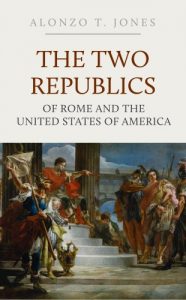Alonzo T. Jones (1850–1923) was a Seventh-day Adventist preacher, teacher and writer whose legacy continues to impact the movement today.
"Rome, in its different phases," writes Jones, "occupies the largest place of any national name in history. Rome, considered with reference to government, is interesting and important. Considered with reference to religion, it is yet more interesting and more important. But when considered with reference to the interrelationship of government and religion, it is most interesting and most important. It is Rome in this last phase that is the principal subject of study in this book. As in this particular Rome occupies on extreme and the United State of America the other, the latter is considered also, though the plan and limit of the book has made it necessary to give less space to this than the subject deserves.
The principle of Rome in all its phases is that religion and government are inseparable. The principle of the government of the United States is that religion is essentially distinct and totally separate from civil government, and entirely exempt from its cognizance.
The principle of Rome is the abject slavery of the mind; the principle of the United States of America is the absolute freedom of the mind.
As it Christianity that first and always antagonized this governmental principle of Rome, and established the governmental principle of the United States of America, the fundamental idea, the one thread-thought of the whole book, is to develop the principles of Christianity with reference to civil government, and to portray the mischievous results of the least departure form those principles."
This classic includes the following chapters:
Preface
I. The Last Days of the Republic
II. The Two Triumvirates
III. The Roman Monarchy
IV. The “Ten Persecutions”
V. Christianity and the Roman Empire
VI. The Rise of Constantine
VII. Ancient Sun Worship
VIII. The Falling Away — The Great Apostasy
IX. The Exaltation of the Bishopric
X. The Religion of Constantine
XI. Constantine and the Bishops
XII. The Union of Church and State
XIII. The Original Sunday Legislation
XIV. Establishment of the Catholic Faith
XV. Arianism Becomes Orthodox
XVI. The Catholic Faith Re-established
XVII. Mary Is Made the Mother of God
XVIII. The Eutychian Controversy
XIX. The Pope Made Author of the Faith
XX. The Church Usurps the Civil Authority
XXI. The Ruin of the Roman Empire
XXII. The Supremacy of the Papacy
XXIII. Protestantism — True and False
XXIV. The New Republic
XXV. The Great Conspiracy
XXVI. The Bond of Union
XXVII. Will It Succeed?
XXVIII. Conclusion
Appendix
"Rome, in its different phases," writes Jones, "occupies the largest place of any national name in history. Rome, considered with reference to government, is interesting and important. Considered with reference to religion, it is yet more interesting and more important. But when considered with reference to the interrelationship of government and religion, it is most interesting and most important. It is Rome in this last phase that is the principal subject of study in this book. As in this particular Rome occupies on extreme and the United State of America the other, the latter is considered also, though the plan and limit of the book has made it necessary to give less space to this than the subject deserves.
The principle of Rome in all its phases is that religion and government are inseparable. The principle of the government of the United States is that religion is essentially distinct and totally separate from civil government, and entirely exempt from its cognizance.
The principle of Rome is the abject slavery of the mind; the principle of the United States of America is the absolute freedom of the mind.
As it Christianity that first and always antagonized this governmental principle of Rome, and established the governmental principle of the United States of America, the fundamental idea, the one thread-thought of the whole book, is to develop the principles of Christianity with reference to civil government, and to portray the mischievous results of the least departure form those principles."
This classic includes the following chapters:
Preface
I. The Last Days of the Republic
II. The Two Triumvirates
III. The Roman Monarchy
IV. The “Ten Persecutions”
V. Christianity and the Roman Empire
VI. The Rise of Constantine
VII. Ancient Sun Worship
VIII. The Falling Away — The Great Apostasy
IX. The Exaltation of the Bishopric
X. The Religion of Constantine
XI. Constantine and the Bishops
XII. The Union of Church and State
XIII. The Original Sunday Legislation
XIV. Establishment of the Catholic Faith
XV. Arianism Becomes Orthodox
XVI. The Catholic Faith Re-established
XVII. Mary Is Made the Mother of God
XVIII. The Eutychian Controversy
XIX. The Pope Made Author of the Faith
XX. The Church Usurps the Civil Authority
XXI. The Ruin of the Roman Empire
XXII. The Supremacy of the Papacy
XXIII. Protestantism — True and False
XXIV. The New Republic
XXV. The Great Conspiracy
XXVI. The Bond of Union
XXVII. Will It Succeed?
XXVIII. Conclusion
Appendix












